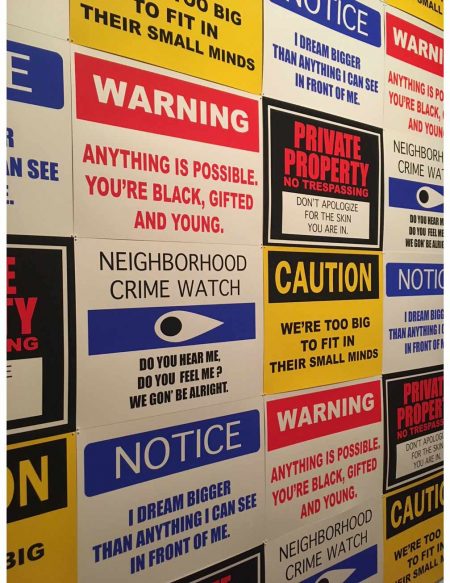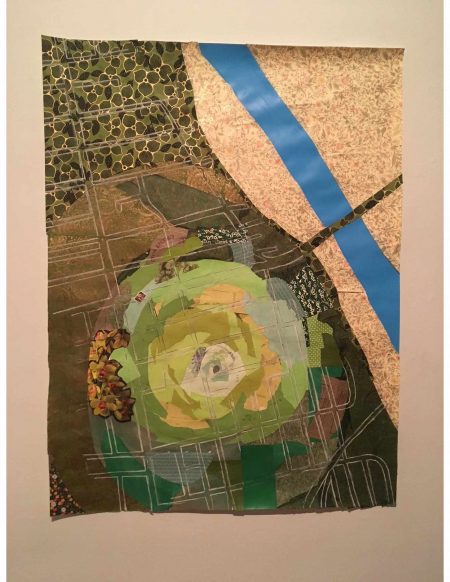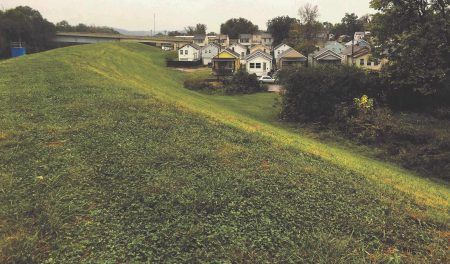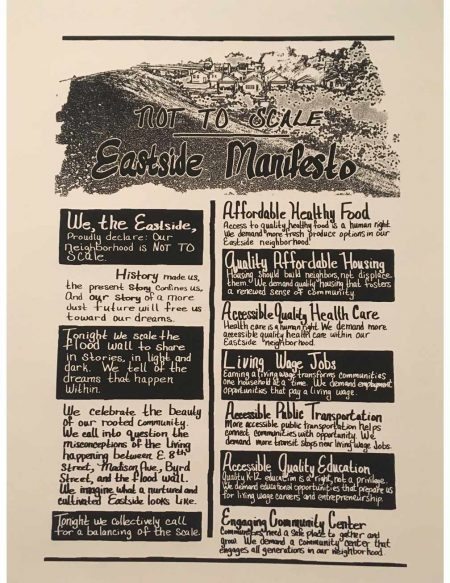From March 2 through April 29, 2018, the Carnegie in Covington, Kentucky is spotlighting an emphatically local meditation on matters of national concern. The museum’s Hutson Gallery features the work of Anissa R. Lewis, Mary Clare Rietz, and a host of citizen-artists from Covington’s Eastside neighborhood, all of them proclaiming the dignity of the community while seeking enriched social and economic conditions for its members. Not to Scale relies on the language of mapping, warning and protest placards, land survey photography, and multimedia installation to supplement and complicate dominant narratives about the area. The idea of “scale” holds at least two connotations in the show, each amplifying and folding into the other. First, it refers to relative magnitude: Lewis suggests that distributions of “city, business, institutional, and non-profit resources” are “‘not to scale’ as compared to other Covington communities” (Demaline). Second, it evokes the balancing of weights that is key to classical images of justice. None of the participants expects that balance to come from the generous intervention of outsiders. If it is to be achieved, they imply, it will depend on the collective action of the inhabitants themselves.

Anissa R. Lewis
That conviction announces itself as soon as we enter the gallery, which confronts us with a large-scale tapestry of warning signs and caution notices, one of which reads “We’re Too Big to Fit in Their Small Minds.” The critical tone imbues much of Lewis’s assemblage of screen prints, coexisting with varied endorsements of communal self-determination. The placards range from “Warning: Anything Is Possible. You’re Black, Gifted and Young” to “Neighborhood Crime Watch: Do You Hear Me, Do You Feel Me? We Gon’ Be Alright” to “Private Property, No Trespassing: Don’t Apologize for the Skin You Are In.” The industrial design of the prints, with their clamorous assertions of primary color, trigger the sense of alert, of imminent trouble and lurking toxicity. The poison inheres not in the Eastside neighborhood itself, though, but in the reductive narratives that envelop it. Those narratives emphasize violent behavior, drug trafficking, and forms of poverty that run across cultural and economic domains. Although poverty and crime constitute pressing concerns in the area, Lewis’s piece refuses to frame the neighborhood solely in terms of its problems. But it also pushes past such refusal toward the designation of alternative epistemologies, splendid stories that have yet to be told.

Anissa R. Lewis
Across the room hangs Lewis’s Open, which continues to juxtapose the iconography of emergency with visions of regeneration. A chalk-like rendering of the Covington street map occupies the majority of the picture plane, with a storm cell of moss and cream circling the Eastside area. The pinwheel of color connotes a swell of energy traversing the landmass south of the river, ragged tendrils spinning off the hub of the storm and threatening the surrounding territory. Yet if we linger we recognize a contrary tendency, as floral prints constitute the dominant materials of the piece, delicate bouquets suffusing the textures of wallpaper and drapery. The impression of a hurricane gives way to blossoming. Diverse media work in tandem with Lewis’s caution signs to signal multiplicity and possibility, rejecting deterministic stories of decline. The piece’s title accentuates the motif of blooming plant life while further signaling Eastside’s cultivation of futurity.

Mary Clare Rietz
Like Lewis, Rietz embeds the contradiction of impending disaster and communal fortitude in the same visual space. Floodwall and Homes, Eastside Neighborhood, Covington, KY affords a view of housing nestled against the riverbank, symmetrical architecture and geometrical street plans sharing space with woodsy flourishes. As with Lewis’s placards and storm swirl, the Licking River Floodwall entails an arresting doubleness: it evokes the threat of a deluge while also guarding against that threat. As the houses cluster together in the top right of the photograph, they evince a pronounced vulnerability. Their size relative to the wall sparks an affect akin to the Romantic sublime, a mutually reinforcing awe and dread. But their proximity to each other, and their huddling in one sector of the picture, coalesce as an assertion of interdependence and solidarity.
The photo’s most resonant detail, however, is the well-worn path that climbs the floodwall and travels along its upper edge. That detail links the still image to performances that took place during February 2018, some of which included citizen-artists marching up the hill together, carrying bright signs and making music to honor the neighborhood. As the highest topographical point in the area, the wall gave the activists a visibility generally not available to them in civic dialogue. In one performance, the marchers moved along the wall in full daylight while ecstatic percussion and chants of “Eastside” accompanied the procession. In another, participants assembled on the hill at night to sing spirituals and share the history of the community, many performers carrying flashlights that cut purposefully through the darkness. Rietz organized the actions and oversaw their digital recording, which would later run on constant loop in the Hutson Gallery. Lewis assembled a related series of installations in the weeks following the floodwall ascent, occupying vacant lots with colorful challenges to their emptiness. Each demonstration asked what filled the space before, why it disappeared, and how the terrain might flower once more.

Mary Clare Rietz, Michelles Slaughter,
Brian Goessling, and Sharon Bass
Opposite the floodwall video hangs the Eastside Manifesto, which extends the show’s organic metaphor by praising “the beauty of our rooted community.” The assertion of rootedness underscores the durability of the area despite recurrent hard times, leaning toward a future of revitalization and continued growth. To make that outcome possible, the manifesto demands “affordable healthy food,” “quality affordable housing,” “accessible quality health care,” “living wage jobs,” “accessible public transportation,” “accessible quality education,” and an “engaging community center.” These demands aim to fortify the existing population rather than dislodge it; invigorating the locale should not mean pricing out its inhabitants or appropriating their territory for other people’s purposes. The manifesto affirms the sort of mobility that retains its organic connection to home, a freedom of movement in both literal and figurative senses. Citizens need ready ways of plugging into the economy, of reaching places where they can perform socially useful and personally fulfilling work. They also need places where they can dine, play, imagine, and plan in safety, and where they can sustain the artistic and political movement that Not to Scale embodies.
The Hutson Gallery affords the briefest glimpse of that movement. At first encounter, the show appears small, with only five pieces available for immediate viewing. It derives greater scale, however, from traces of events that preceded the Carnegie display and that continue outside the museum’s confines. In its emphasis on multimodal kinetics, Not to Scale extols the kind of political theater that cannot be contained by the gallery. And with its eclectic combination of materials, from screen prints to photographs to scrolls to videos to singing bodies, it endeavors to honor Eastside’s complex history. Insistently local as it is, the exhibit continues the long, geographically distributed story of activism at the intersection of race and social class, and thereby tends a claim whose yield holds nationwide significance.
–Christopher Carter
Works Cited
Demaline, Jackie. “New Art Show Opens at Carnegie, Including Showcase of Covington’s Eastside.” River City News Arts, 7 Mar. 2018, http://www.rcnky.com/articles/2018/03/07/new-art-shows-open-carnegie-including-showcase-covingtons-eastside. Accessed 13 Mar. 2018. articles.html